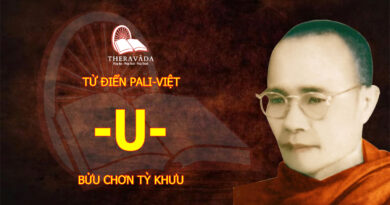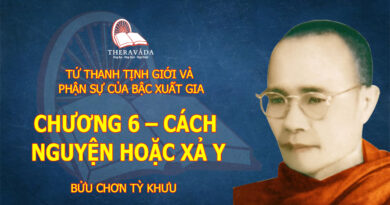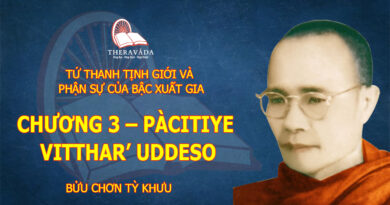Chapter 9: The Goal – The Art Of Living
Chapter 9. THE GOAL
“Whatever has the nature of arising also has the nature of cessation.”1 The experience of this reality is the essence of the teaching of the Buddha. Mind and body are merely a bundle of processes that are constantly arising and passing away. Our suffering arises when we develop attachment to the processes, to what is in fact ephemeral and insubstantial. If we can realize directly the impermanent nature of these processes, our attachment to them passes away. This is the task that meditators undertake: to understand their own transient natures by observing the ever-changing sensations within. Whenever a sensation occurs they do not react, but allow it to arise and to pass away. By doing so they allow the old conditioning of the mind to come to the surface and pass away. When conditioning and attachment cease, suffering ceases, and we experience liberation. It is a long task requiring continual application. Benefits appear at every step along the way, but to attain them requires repeated effort. Only by working patiently, persistently, and continuously can the meditator advance toward the goal.
Penetration to Ultimate Truth
There are three stages in one’s progress on the path. The first is simply learning about the technique, how it is done and why. The second is putting it into practice. The third is penetration, using the technique in order to pierce to the depths of one’s reality and thereby to progress toward the final goal.
The Buddha did not deny the existence of the apparent world of shapes and forms, colours, tastes, smells, pains and pleasures, thoughts and emotions, of beings—oneself and others. He stated merely that this is not the ultimate reality. With ordinary vision, we perceive only the large-scale patterns into which more subtle phenomena organize themselves. Seeing only the patterns and not the underlying components, we are aware primarily of their differences, and therefore we draw distinctions, assign labels, form preferences and prejudices, and commence liking and disliking—the process that develops into craving and aversion.
In order to emerge from the habit of craving and aversion, it is necessary not only to have an overall vision, but to see things in depth, to perceive the underlying phenomena that compose apparent reality. This is precisely what the practice of Vipassana meditation allows us to do.
Any self-examination naturally begins with the most obvious aspects of ourselves: the different parts of the body, the various limbs and organs. Closer inspection will reveal that some parts of the body are solid, others are liquid, others are in motion or at rest. Perhaps we perceive the bodily temperature as distinct from the temperature of the surrounding atmosphere. All these observations may help to develop greater self-awareness, but they are still the result of examining apparent reality in a composed shape or form. Therefore distinctions persist, preferences and prejudices, craving and aversion.
As meditators we go further by practising awareness of sensations within. These certainly reveal a subtler reality of which we were previously ignorant. At first we are aware of different types of sensations in different parts of the body, sensations that seem to arise, to remain for some time, and eventually to pass away. Although we have advanced beyond the superficial level, we are still observing the integrated patterns of apparent reality. For this reason we are not yet free from discriminations, from craving and aversion.
If we continue practising diligently, sooner or later we arrive at a stage where the nature of the sensations changes. Now we are aware of a uniform type of subtle sensations throughout the body, arising and passing away with great rapidity. We have penetrated beyond the integrated patterns to perceive the underlying phenomena of which they are composed, the subatomic particles of which all matter is constituted. We experience directly the ephemeral nature of these particles, continually arising and vanishing. Now whatever we observe within, whether blood or bone, solid, liquid, or gaseous, whether ugly or beautiful, we perceive only as a mass of vibrations that cannot be differentiated. At last the process of drawing distinctions and assigning labels ceases. We have experienced within the framework of our own bodies the ultimate truth about matter: that it is constantly in flux, arising and passing away.
Similarly, the apparent reality of mental processes may be penetrated to a subtler level. For example, a moment of liking or disliking occurs, based on one’s past conditioning. Next moment the mind repeats the reaction of liking or disliking, and reinforces it moment after moment until it develops into craving or aversion. We are aware only of the intensified reaction. With this superficial perception we begin to identify and discriminate between pleasant and unpleasant, good and bad, wanted and unwanted. But just as in the case of apparent material reality, so with intensified emotion: when we start to observe it by observing sensations within, it is bound to dissolve. As matter is nothing but subtle wavelets of subatomic particles, so strong emotion is merely the consolidated form of momentary likings and dislikings, momentary reactions to sensations. Once strong emotion dissolves into its subtler form, it no longer has any power to overwhelm.
From observing different consolidated sensations in different parts of the body, we proceed to awareness of subtler sensations of uniform nature, arising and vanishing constantly throughout the physical structure. Because of the great rapidity with which the sensations appear and disappear, they may be experienced as a flow of vibrations, a current moving through the body. Wherever we fix the attention within the physical structure, we are aware of nothing but arising and vanishing. Whenever a thought appears in the mind, we are aware of the accompanying physical sensations, arising and passing away. The apparent solidity of body and mind dissolves, and we experience the ultimate reality of matter, mind, and mental formations: nothing but vibrations, oscillations, arising and vanishing with great rapidity. As one who experienced this truth said,
The entire world is ablaze,
the entire world is going up in smoke.
The entire world is burning
the entire world is vibrating.
To reach this stage of dissolution (bhaṅga), the meditator need do nothing but develop awareness and equanimity. Just as a scientist can observe more minute phenomena by increasing the magnification of his microscope, so by developing awareness and equanimity one increases the ability to observe subtler realities within.
This experience, when it occurs, is certainly very pleasant. All the aches and pains have dissolved, all the areas without sensation have disappeared. One feels peaceful, happy, blissful. The Buddha described it as follows:
Whenever one experiences
the arising and passing away of the mental-physical processes, he enjoys bliss and delight.
He attains the deathless, as realized by the wise.3
Bliss is bound to arise as one advances on the path, when the apparent solidity of mind and body has been dissolved. Delighting in the pleasant situation, we may think that it is the final goal. But it is only a way-station. From this point we proceed further to experience the ultimate truth beyond mind and matter, to attain total freedom from suffering.
The meaning of these words of the Buddha becomes very clear to us from our own practice in meditation. Penetrating from apparent to subtle reality, we begin to enjoy the flow of vibrations throughout the body. Then suddenly the flow is gone. Again we experience intense, unpleasant sensations in some parts, and perhaps no sensation in other parts. Again we experience intense emotion in the mind. If we start feeling aversion toward this new situation and craving for the flow to return, we have not understood Vipassana. We have turned it into a game in which the goal is to achieve pleasant experiences and to avoid or overcome unpleasant ones. This is the same game that we have played throughout life—the unending round of push and pull, of attraction and repulsion, which leads to nothing but misery.
As wisdom increases, however, we recognize that the recurrence of gross sensations, even after the experience of dissolution, indicates not regression but rather progress. We practise Vipassana not with the aim of experiencing any particular kind of sensation, but in order to free the mind of all conditioning. If we react to any sensation, we increase our suffering. If we remain balanced, we allow some of the conditioning to pass away and the sensation becomes a means to liberate us from suffering. By observing unpleasant sensations without reacting, we eradicate aversion. By observing pleasant sensations without reacting, we eradicate craving. By observing neutral sensations without reacting, we eradicate ignorance. Therefore no sensation, no experience is intrinsically good or bad. It is good if one remains balanced; it is bad if one loses equanimity.
With this understanding we use every sensation as a tool to eradicate conditioning. This is the stage known as saṅkhāra-upekkhā, equanimity toward all conditioning, which leads step by step to the ultimate truth of liberation, nibbāna.
The Experience of Liberation
Liberation is possible. One can attain freedom from all conditioning, all suffering. The Buddha explained:
There is a sphere of experience that is beyond the entire field of matter, the entire field of mind, that is neither this world nor another world nor both, neither moon nor sun. This I call neither arising, nor passing away, nor abiding, neither dying nor rebirth. It is without support, without development, without foundation. This is the end of suffering.4
He also said
There is an unborn, unbecome, uncreated, unconditioned. Were there not an unborn, unbecome, uncreated, unconditioned, no release would be known from the born, the become, the created, the conditioned. But since there is an unborn, unbecome, uncreated, unconditioned, therefore a release is known from the born, the become, the created, the conditioned.5
Nibbāna is not just a state one goes to after death; it is something to be experienced within oneself here and now. It is described in negative terms not because it is a negative experience but because we have no other way in which to describe it. Every language has words to deal with the entire range of physical and mental phenomena, but there are no words or concepts to describe something that is beyond mind and matter. It defies all categories, all distinctions. We can describe it only by saying what it is not.
In fact it is meaningless to try to describe nibbāna. Any description will only be confusing. Rather than discussing and arguing about it, the important thing is to experience it. “This noble truth of the cessation of suffering must be realized for oneself,” the Buddha said.6 When one has experienced nibbāna, only then is it real for him; then all arguments about it become irrelevant.
In order to experience the ultimate truth of liberation, it is necessary first to penetrate beyond apparent reality and to experience the dissolution of body and mind. The further one penetrates beyond apparent reality, the more one desists from craving and aversion, from attachments, and the nearer one approaches to ultimate truth. Working step by step, one naturally reaches a stage where the next step is the experience of nibbāna. There is no point in yearning for it, no reason to doubt that it will come. It must come to all who practise Dhamma correctly. When it will come, no one can say. This depends partly on the accumulation of conditioning within each person, partly on the amount of effort one expends to eradicate it. All one can do, all one need to do to attain the goal, is to continue observing each sensation without reacting.
We cannot determine when we shall experience the ultimate truth of nibbāna, but we can ensure that we keep progressing toward it. We can control the present state of mind. By maintaining equanimity no matter what occurs outside or within us, we achieve liberation in this moment. One who had attained the ultimate goal said, “Extinction of craving, extinction of aversion, extinction of ignorance—this is called nibbāna.”7 To the extent that the mind is freed of these, one experiences liberation.
Every moment in which we practise Vipassana properly, we can experience this liberation. After all, Dhamma by definition must give results here and now, not only in the future. We must experience its benefits at every step along the way, and every step must lead directly to the goal. The mind that at this moment is free from conditioning is a mind at peace. Each such moment brings us closer to total liberation.
We cannot strive to develop nibbāna, since nibbāna does not develop; it simply is. But we can strive to develop the quality that will lead us to nibbāna, the quality of equanimity. Every moment that we observe reality without reacting, we penetrate toward ultimate truth. The highest quality of the mind is equanimity based on full awareness of reality.
Real Happiness
Once the Buddha was asked to explain real happiness. He enumerated various wholesome actions which are productive of happiness, which are real blessings. All these blessings fall into two categories: performing actions that contribute to the welfare of others by fulfilling responsibilities to family and society, and performing actions that cleanse the mind. One’s own good is inextricable from the good of others. And at last he said,
When faced with all the ups and downs of life, still the mind remains unshaken,
not lamenting, not generating defilements, always feeling secure; this is the greatest happiness.8
No matter what arises, whether within the microcosm of one’s own mind and body or in the world outside, one is able to face it— not with tension, with barely suppressed craving and aversion—but with complete ease, with a smile that comes from the depths of the mind. In every situation, pleasant or unpleasant, wanted or unwanted, one has no anxiety, one feels totally secure, secure in the understanding of impermanence. This is the greatest blessing.
Knowing that you are your own master, that nothing can over-power you, that you can accept smilingly whatever life has to offer—this is perfect balance of the mind, this is true liberation. This is what can be attained here and now through the practice of Vipassana meditation. This real equanimity is not merely negative or passive aloofness. It is not the blind acquiescence or apathy of one who seeks escape from the problems of life, who tries to hide his head in the sand. Rather, true mental balance is based on full awareness of problems, awareness of all levels of reality.
The absence of craving or aversion does not imply an attitude of callous indifference, in which one enjoys one’s own liberation but gives no thought to the suffering, of others. On the contrary, real equanimity is properly called “holy indifference.” It is a dynamic quality, an expression of purity of mind. When freed of the habit of blind reaction, the mind for the first time can take positive action which is creative, productive, and beneficial for oneself and for all others. Along with equanimity will arise the other qualities of a pure mind: good will, love that seeks the benefit of others without expecting anything in return; compassion for others in their failings and sufferings; sympathetic joy in their success and good fortune. These four qualities are the inevitable outcome of the practice of Vipassana
Previously one always tried to keep whatever was good for oneself and pass anything unwanted on to others. Now one understands that one’s own happiness cannot be achieved at the expense of others, that giving happiness to others brings happiness to oneself. Therefore one seeks to share whatever good one has with others. Having emerged from suffering and experienced the peace of liberation, one realizes that this is the greatest good. Thus one wishes that others may also experience this good, and find the way out of their suffering.
This is the logical conclusion of Vipassana meditation: mettā-bhāvanā, the development of good will toward others. Previously one may have paid lip service to such sentiments, but deep within the mind the old process of craving and aversion continued. Now to some extent the process of reaction has stopped, the old habit of egoism is gone, and good will naturally flows from the depths of the mind. With the entire force of a pure mind behind it, this good will can be very powerful in creating a peaceful and harmonious atmosphere for the benefit of all.
There are those who imagine that always remaining balanced means that one can no longer enjoy life in all its variety, as if a painter had a palette full of colours and chose to use nothing but gray, or as if one had a piano and chose to play nothing but middle C. This is a wrong understanding of equanimity. The fact is that the piano is out of tune and we do not know how to play it. Simply pounding the keys in the name of self-expression will only create discord. But if we learn how to tune the instrument and to play it properly, then we can make music. From the lowest to the highest note we use the full range of the keyboard, and every note that we play creates nothing but harmony, beauty.
The Buddha said that in cleansing the mind and attaining “wisdom brought to full perfection,” one experiences “joy, bliss tranquility, awareness, full understanding, real happiness.”9 With a balanced mind we can enjoy life more. When a pleasant situation occurs, we can savour it completely, having full and undistracted awareness of the present moment. But when the experience passes, we do not become distressed. We continue to smile, understanding that it was bound to change. Equally, when an unpleasant situation occurs, we do not become upset. Instead we understand it and by doing so perhaps we find a way to alter it. If that is not within our power, then we still remain peaceful, knowing full well that this experience is impermanent, bound to pass away. In this way, by keeping the mind free of tension, we can have a more enjoyable and productive life.
There is a story that in Burma people used to criticize the students of Sayagyi U Ba Khin, saying that they lacked the serious demeanor proper to those who practise Vipassana meditation. During a course, the critics admitted, they worked seriously, as they should, but afterward they always appeared happy and smiling. When the criticism came to the ears of Webu Sayadaw, one of the most highly respected monks in the country, he replied, “They smile because they can smile.” Theirs was a smile not of attachment or ignorance, but of Dhamma. Someone who has cleansed the mind will not go about with a frown. When suffering is removed, naturally one smiles. When one learns the way to liberation, naturally one feels happy.
This smile from the heart expressing nothing but peace, equanimity and good will, a smile that remains bright in every situation, is real happiness. This is the goal of Dhamma.




